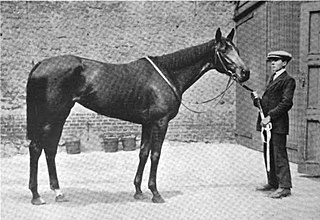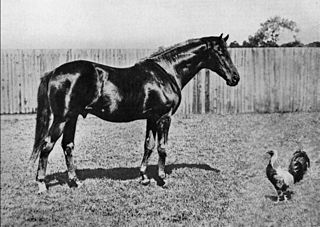 W
WBlack Jester (1911–1928) was a British Thoroughbred racehorse and sire, best known for winning the Classic St Leger Stakes in 1914. The colt won nine times from twenty-three races in a track career which lasted from 1913 until October 1915. Black Jester was one of the leading two-year-olds of 1913 when he won both Molecomb Stakes and the Richmond Stakes at Goodwood. As a three-year-old he finished third in the 2000 Guineas and was unplaced in The Derby before winning the Sussex Stakes at Goodwood and the St Leger at Doncaster in September. In 1915 he won the City and Suburban Handicap and the June Stakes, a wartime substitute for the Coronation Cup. He became increasingly difficult to train and at the end of the season he was retired to stud where he became a successful sire of broodmares.
 W
WDurbar was a French racehorse. Although not the best of his generation in France he proved too good for the leading British colts in the 1914 Epsom Derby, which he won by three lengths. His pedigree was controversial, with the British authorities not recognising him as a Thoroughbred. His racing career was ended by the outbreak of the First World War.
 W
WKennymore was a British Thoroughbred racehorse and sire. He was a highly talented horse whose career was adversely affected by his difficult temperament. He did not appear until the autumn of his two-year-old season but made an immediate impact as he finished third in the Middle Park Stakes and then won the Dewhurst Stakes. In the following spring he won the Craven Stakes and the 2000 Guineas but lost his chance in the Epsom Derby when he became highly agitated before the start. He went on to finish third in the Eclipse Stakes and second in the St Leger before winning the Newmarket St Leger on his final appearance. He died at the age of five in 1916 after a single season at stud.
 W
WLuke McLuke was a bay Thoroughbred stallion born in the United States; he won the 1914 Belmont Stakes, the Carlton Stakes, Kentucky Handicap, and Grainger Memorial Handicap among his four wins from six starts. After his racing career was over, he became a breeding stallion, where he sired 11 stakes winners. Two of his daughters were named as year-end Champions in the United States.
 W
WOld Rosebud was an American Thoroughbred racehorse whose pedigree traced to the influential sire Eclipse, and through Eclipse to the founding stallion, the Darley Arabian. In the list of the top 100 U.S. thoroughbred champions of the 20th Century by Blood-Horse magazine, Old Rosebud ranks 88th. Despite a successful racing career, Old Rosebud was plagued by ailments throughout his life, culminating in a fatal injury at a claiming race when he was 11 years old.
 W
WPrincess Dorrie was a British Thoroughbred racehorse and broodmare. As a two-year-old in 1913 she failed to win a race but was very consistent, finishing placed in seven of her eight starts. In the following year she was probably the best three-year-old filly in England, winning both the 1000 Guineas and the Epsom Oaks. She was retired at the end of the 1914 season and had modest success as a broodmare.
 W
WRoamer (1911–1920) was an American thoroughbred racehorse. In the Blood-Horse magazine's list of the top 100 U.S. thoroughbred champions of the 20th Century, the gelding Roamer was ranked #99.
 W
WSon-in-Law was a British Thoroughbred racehorse and an influential sire, especially for sport horses.
 W
WThe Tetrarch (1911–1935) was an Irish-bred, British-trained Thoroughbred racehorse. He was undefeated in a racing career of seven starts and was voted the best British-trained two-year-old of the 20th century according to the National Horseracing Museum. He did not race after 1913 and was retired to stud where he became an influential sire.